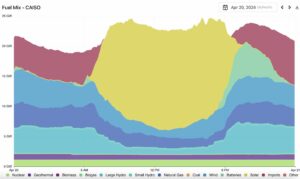NSW, host to the biggest state grid in Australia, and the largest coal fleet, has posted a stunning new leap to register a new record for “native” demand in the latest heatwave, but rooftop solar on consumer households helped ease the stress on the grid.
On Thursday, “native demand” leapt above 15 gigawatt for the first time to reach a peak of 15.6 GW at 3.10pm (grid time, or AEST) on Thursday. That was a stunning 730 MW above the previous peak of 14.77 reached on December 14 last year.
But the growing importance of rooftop solar meant that “operational demand” – the part that requires a response from available generators – did not reach a new peak.
In fact, at its highest – 13.64 GW, reached at 5pm grid time – was only the third highest, and 192 MW below the peak set four years ago on March 1, 2020. (See graph below).

NEMLog
The impact on the grid of this summer’s heatwaves, the response of fossil generators, renewables and storage, and the effect on prices have been scrutinised in detail by energy boffins as evidence for or against the impending closure of Eraring, the country’s biggest coal generator.
That 2.88 GW facility is currently scheduled to close in August next year, and talks about a possible extension with the state government have been dragging on for more than six months.
It is assumed that the discussion are focused on how to keep one or two units operating, possibly in reserve, for another summer or two to allow for more renewables and storage to be in place, and who should bear the cost.
Thursday’s data provides a number of interesting observations. The first one is the role of rooftop PV, which accounted for more than 2.1 GW at the native peak in the middle of the afternoon, when temperatures were the fiercest.
The second thing to observe is that rooftop solar has pushed the “operational” peak to the late afternoon, and even then it is still making a contribution of around 11 per cent of total demand.
Energy analys David Osmond observed this week that in last week’s record for demand across the whole of the National Electricity Market – 38 GW – rooftop PV was providing over 7 GW, greatly reducing peak grid demand, which instead occured 90 minutes later at around 33.3 GW, a 13% reduction.
He has since extrapolated NEM data and found that solar is likely pushing down grid demand peaks by around 13 per cent for the current capacity of rooftop PV, rising to close to 15 per cent in five years, and to 22 per cent if solar PV was better matched with household batteries.

A greater focus on rooftop PV, batteries and demand management is being urged by many quarters as an important part of managing the energy transition, and this seems to be supported by greater interest from consumers taking a closer look at energy options as they look to buy EVs, and think about charging.
As for the grid response in NSW on Thursday, it was notable that wind died down considerably in the afternoon, the state’s hydro resources provided much of the flexible response, and the coal generators were all in solid use.
And prices also peaked at $16,600 MWh at multiple intervals, driven by incredibly small amounts of diesel generation, which nevertheless helped set the price at the market cap. NSW currently only has a couple of big batteries, and these were injecting more into the grid at the time.










